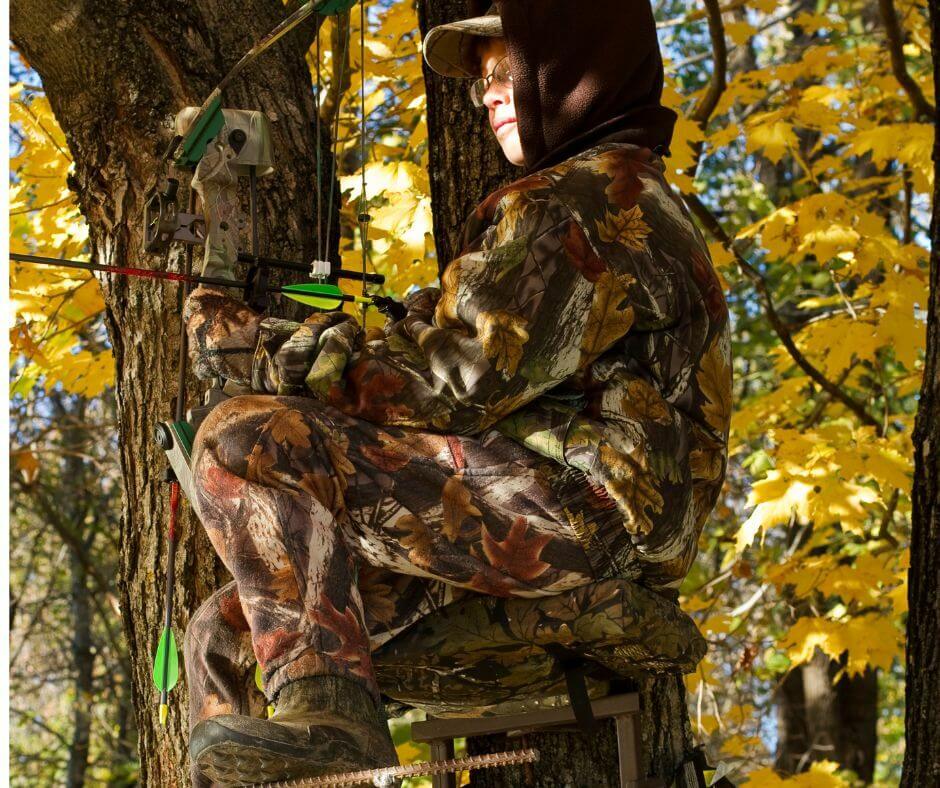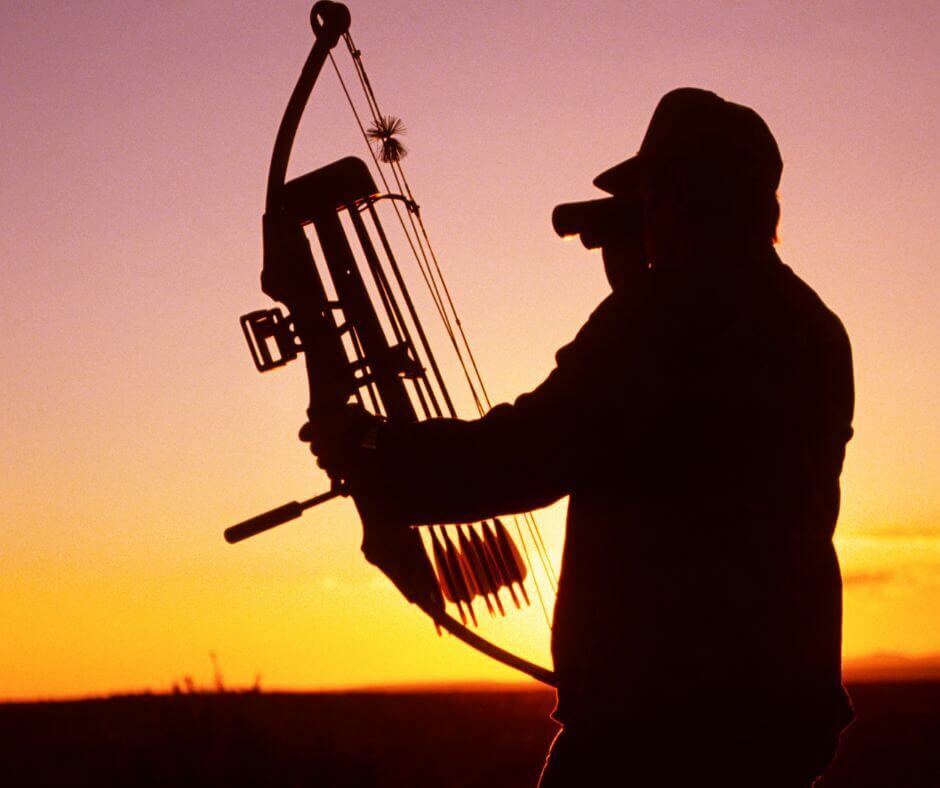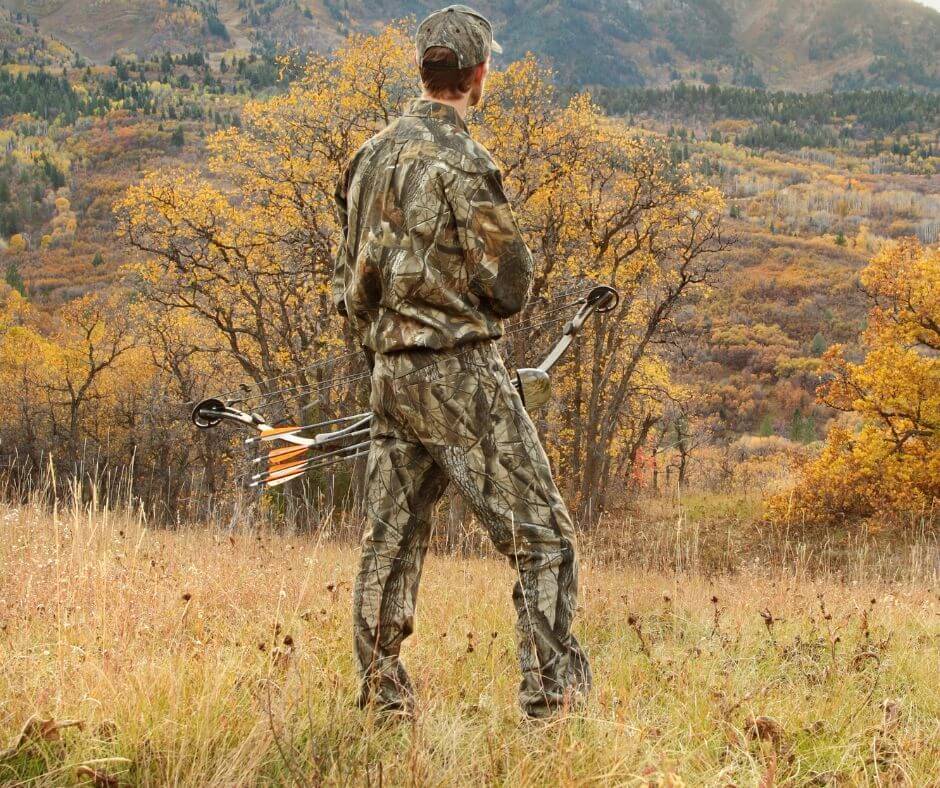Bowhunting in the fall carries with it a distinct mystique—a fusion of skill, patience, and oneness with nature, heightened by the kaleidoscope of colors that Michigan’s hardwood forests generously display. As the foliage turns from vibrant greens to rich golds and reds, the hardwoods become both a challenge and an ally to the bowhunter. This article will guide you through the intricacies of bowhunting amidst this captivating terrain, contrasting the thrill it offers with other hunting methods. Understanding the hardwood landscape is pivotal not just for the hunt’s success but also for the profound connection it establishes between the hunter and the wilderness.
The Basics of Bowhunting in Hardwood Forests
 When hunting in Michigan’s hardwood forests certain skills and considerations are necessary. Unlike open terrains or grasslands, hardwoods present challenges for bowhunters due to the dense canopy. Camouflage becomes crucial in blending with the fall foliage which constantly changes colors. Tracking game in this environment requires keen senses and a deep understanding of wildlife behavior. The gear you choose also plays a key role, from selecting the right bow to ensuring arrow precision. Every choice shapes your hunt in Michigan’s iconic hardwoods which are known for their beauty. Below are a few basics to consider when bowhunting in Michigan’s Hardwood Forests this fall:
When hunting in Michigan’s hardwood forests certain skills and considerations are necessary. Unlike open terrains or grasslands, hardwoods present challenges for bowhunters due to the dense canopy. Camouflage becomes crucial in blending with the fall foliage which constantly changes colors. Tracking game in this environment requires keen senses and a deep understanding of wildlife behavior. The gear you choose also plays a key role, from selecting the right bow to ensuring arrow precision. Every choice shapes your hunt in Michigan’s iconic hardwoods which are known for their beauty. Below are a few basics to consider when bowhunting in Michigan’s Hardwood Forests this fall:
- Terrain Distinctions: The hardwood forests of Michigan are notably different from other hunting terrains. These dense woods, dominated by trees like oaks, maples, and hickories, form a tight canopy that often limits visibility. Unlike open terrains or grasslands where game can be spotted from significant distances, hardwoods necessitate close-range encounters, making each step critical and the hunt intensely personal.
- The Art of Camouflage: As the leaves transition from summer greens to autumnal oranges, yellows, and reds, the bowhunter must also adapt. It isn’t just about blending in but becoming a part of the forest tableau. This involves not only wearing the right colors but also understanding the play of light and shadow in the woods, choosing spots that neither silhouette nor expose the hunter.
- Nuanced Tracking: In hardwood forests, traditional game spotting techniques might not always apply. With a carpet of fallen leaves, every step can be both a giveaway and a mask. Listening becomes as crucial as watching. Understanding the behavior of animals like whitetail deer during the rut, their feeding times, and their preferred bedding areas can give a bowhunter the edge.
- Essential Equipment Choices: The thickness and close quarters of hardwood terrains demand equipment that’s both compact and efficient. A shorter axle-to-axle bow might be preferable for maneuvering between trees. Arrows need to be chosen for their flight characteristics and penetration capabilities, especially when the target might only be a few yards away. Moreover, the broadhead’s design can make a significant difference in the outcome, especially when shots need to cut through small branches or foliage before reaching the game.
- Game Patterns in Hardwoods: The hardwood forest ecosystem, with its acorns and nuts, is a primary food source for many game animals during the fall. Recognizing areas with abundant mast can be the key to locating game. Moreover, understanding the subtle signs, from scrapes and rubs on trees by bucks to the faint trails worn down by repeated use, can provide invaluable insights into animal movement and behavior.
By grasping these basics, bowhunters can significantly enhance their chances of success and truly appreciate the unparalleled experience of hunting in Michigan’s iconic hardwood forests.
The Species You’ll Encounter
 Michigan’s forests are bustling with various game species during the fall making it a sought-after destination for bowhunters. The most prominent among them is the whitetail deer. With the arrival of autumn, these majestic creatures undergo behavioral changes known as the rut, making them more visible and vulnerable. Hunting strategies must be adapted to their heightened senses and fall behavior.
Michigan’s forests are bustling with various game species during the fall making it a sought-after destination for bowhunters. The most prominent among them is the whitetail deer. With the arrival of autumn, these majestic creatures undergo behavioral changes known as the rut, making them more visible and vulnerable. Hunting strategies must be adapted to their heightened senses and fall behavior.
Wild turkeys pose another challenge for bowhunters due to their sharp eyesight. Successfully hunting them in the woods requires patience and strategic planning. Other animals that bowhunters may encounter include squirrels, rabbits, and the elusive black bear. Each species requires a different approach, understanding their specific signs such as turkey roosting spots or squirrel foraging paths. Knowing the peak activity times for each species during the autumn season is crucial for a successful hunt, transforming a day in the woods from observation to active engagement.
Ethical Bowhunting and Conservation
Bowhunting is more than just a sport or a means to procure game; it’s a responsibility. Ethical practices underpin the true essence of the hunting tradition, ensuring that the activity is sustainable and respectful to both the game and the environment. In Michigan’s hardwoods, the dense forests and close encounters magnify the importance of making clean, humane shots. The bowhunter’s role isn’t just about taking game; it’s also about wildlife management.
Through selective hunting, one can help in maintaining a balance in game populations, ensuring healthier herds and flocks. Michigan’s Department of Natural Resources sets regulations, such as bag limits and seasons, grounded in conservation science. By adhering to these guidelines, hunters play an integral part in preserving the habitats and ecosystems they cherish.
Beyond regulations, ethical hunting also calls for respecting private property, practicing safe hunting methods, and, at the heart of it all, appreciating the intrinsic value of the game and the wilderness. Through such practices, bowhunters can ensure the continuation of hunting traditions and the conservation of Michigan’s rich biodiversity for generations to come.
Tips and Techniques for Successful Bowhunting
 Success in bowhunting, especially in Michigan’s hardwoods, requires preparation, skill, and adaptability. Proficiency with a bow is crucial. Prior to the season, regular practice in conditions resembling the hunt can make a big difference. Adapting to the quietness and tight spaces of the hardwoods may require adjusting draw or release technique. Navigating the terrain silently, selecting a visible yet concealed spot, and understanding wind direction for scent management are all part of bowhunting. Scouting is vital too. Identifying game trails, bedding areas, and food sources like oak stands can set the stage for an encounter. Equipment choice, such as tree stands or scent elimination products, should match the forest. In hardwood bowhunting, every detail matters, making the hunt a dance of patience, strategy, and execution.
Success in bowhunting, especially in Michigan’s hardwoods, requires preparation, skill, and adaptability. Proficiency with a bow is crucial. Prior to the season, regular practice in conditions resembling the hunt can make a big difference. Adapting to the quietness and tight spaces of the hardwoods may require adjusting draw or release technique. Navigating the terrain silently, selecting a visible yet concealed spot, and understanding wind direction for scent management are all part of bowhunting. Scouting is vital too. Identifying game trails, bedding areas, and food sources like oak stands can set the stage for an encounter. Equipment choice, such as tree stands or scent elimination products, should match the forest. In hardwood bowhunting, every detail matters, making the hunt a dance of patience, strategy, and execution.
Embracing Michigan’s Hardwood Bowhunting Experience
Bowhunting in Michigan’s hardwoods is a fulfilling journey that combines skill and respect for nature. It’s not just about hunting but immersing oneself in a colorful and ever-changing tapestry of sights, sounds, and experiences. Both experienced and new bowhunters create lasting memories against the backdrop of autumn leaves and the peaceful forest. Beyond the excitement of the hunt, there is a profound connection to the land, its creatures, and the time-honored traditions of hunting. Let’s reflect on the world of hardwood bowhunting and inspire others by sharing stories, learning from experiences, and passing on the values of respect, conservation, and love for the wilderness to future bowhunters.
